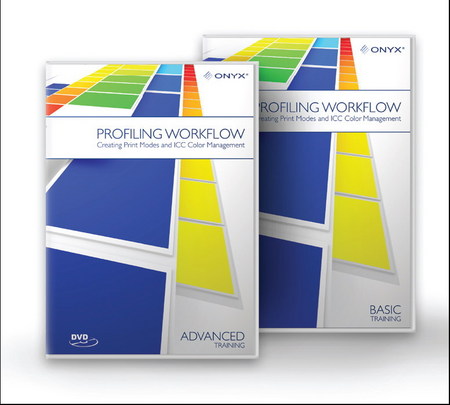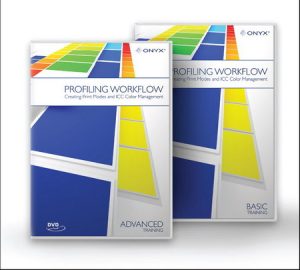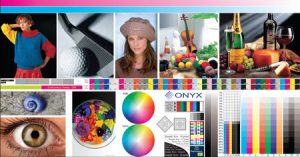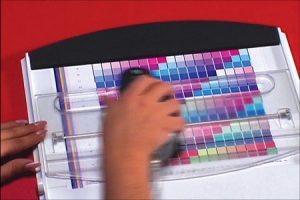Onyx Graphics Inc. is well established in the wide-format, color-printing industry. The company’s PosterShop and ProductionHouse RIPs are installed in signshops, both large and small. The modular products encourage numerous upgrades. Quite compelling is the ability to create custom ICC profiles, which allow third-party media and inks, and insure optimum image quality. So, why wouldn’t everyone jump on the profiling bandwagon? Well, there are numerous reasons.
To begin, you must invest in a color-density measuring device. Options abound. Onyx sells the X-Rite Eye-One spectrophotometer. Reasonably priced, this device offers modes to measure single swatches or entire strips of swatches. The device attaches to the system with a USB cable and works directly in the system’s Media Manager module. The software, of course, works with various devices; your existing one is probably supported.
Let’s assume you just purchased the profiling module and a measuring device. First, launch the “Name of Module.” In approximately two minutes, you’ll quickly face an overwhelming number of steps. You can build your own, though, as we’ve seen, the result is less than spectacular.
So, what are your options? You can hire a specialist. These folks aren’t cheap, and you may not use them enough. You could, of course, buy instructional books, attend classes or rely on trial and error. Can you justify the time and money for this long and hard learning curve?
At this point, you’ll either give up and use a custom-profiling service, or just stick with manufacturer- provided supplies. Your new measuring device, inevitably, will collect dust, and now you have a module that you’ll never use again.
Onyx recognized this issue. It recently introduced two training DVDs that detail the steps of building purpose-driven profiles. A beginner’s DVD tackles startup, and an advanced one gets you rolling. They’re great. As ProductionHouse users, we’ve always wanted to better utilize the profiling capabilities. Now we’ve had our chance.
Advertisement
The Beginner’s DVD
The Beginner’s DVD teaches you how to create “purpose-driven” ICC profiles. What does that mean? Well, your digital printer can be used numerous ways. A solvent printer may be used for outdoor signage, and closely viewed, point-of-purchase (POP) signage. You may want a profile for highest-speed printing. Quality is somewhat secondary.
But POP signage must be top quality. The media and ink may be the same, but the number of passes, direct-printing options (unidirectional vs. bidirectional) and resolution will undoubtedly differ.
Onyx wants you remember the profile’s purpose.
The DVDs have a typical chapter selection that’s critical for reference. Excellent sound and lighting team with easy-to-follow dialog. The full computer-screen scenes are very legible. Don’t expect an action-packed adventure, though the presenters do well with pretty dry stuff.
Advertisement
The DVD opens with a Getting Started section about how to launch the Media Manager application and setting your measuring device. In the DVD, the instructors use the Eye-One. In addition, they explain the printer’s capabilities and how color and resolution create purpose-specific settings.
The next chapter, creating a new media, clears up some misconception about some of Media Manager’s confusing menus.
In essence, creating a new media requires multiple steps. It assigns a name to a new material. Assume you found a good deal on some new photo paper. You must name the media so you can reference it in the RIP. However, you may have different printer settings for a given media. The number of passes and resolution may differ, so you should create a Mode.
The following three chapters discuss tedious aspects of creating profiles (where the various targets and swatches are printed and measured). The DVD explains how to perform the steps and what the software does with the information. You first determine ink restrictions. Next, the actual calibration is covered. Finally, the inks limits are set and checked. The video’s instructors explain their actions.
For the last section, you’ll create a profile. Be prepared to use approximately 25 ft. of paper and produce nearly 900 swatches of various colors. Make sure your printer is calibrated, meaning all jets are firing and the paper tracking is true, before getting started. A fully functional printer obviously provides much better results. The DVD shows the relationship of the swatch print, the Eye One device and the tray for scanning the swatches. It seems unbelievably hard at first, but the video shows the functions in sequence. In the end, everything will tie together.
Advertisement
As you scan the swatches, the screen displays the relationship and values. Review it repeatedly before you try it yourself. The video describes what’s happening, what to expect, what to do if you make a mistake and much more. We’ve produced numerous profiles, and this really fills the gaps.
The advanced DVD highlights the basics of creating ICC color profiles, plus tips on fine tuning the basic profile. This means the color is more finite. For instance, each color is sampled at 5% for the basic profile (generally good enough). In the advanced portion, the color sample is 2%. You’ll find more tips and tricks.
In conclusion, the DVD training library was extremely helpful. Just to understand the components and how they work together can be overwhelming, but the DVDs put it all together. We all know ICC profiles are a necessary evil, but sometimes we ignore the obvious and over-extend matching a color without producing proper color profiles. With an Onyx system, there’s no excuse not to get those colors right.



 Photo Gallery2 weeks ago
Photo Gallery2 weeks ago
 Ask Signs of the Times2 weeks ago
Ask Signs of the Times2 weeks ago
 Paula Fargo1 week ago
Paula Fargo1 week ago
 Real Deal5 days ago
Real Deal5 days ago
 Photo Gallery1 week ago
Photo Gallery1 week ago
 Women in Signs2 weeks ago
Women in Signs2 weeks ago
 Projects5 days ago
Projects5 days ago
 Women in Signs2 weeks ago
Women in Signs2 weeks ago












